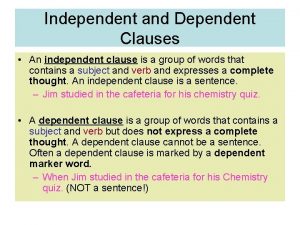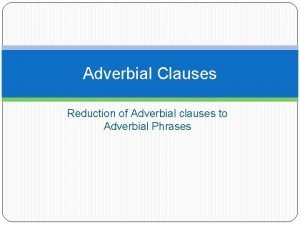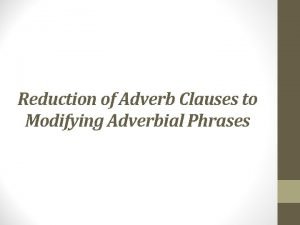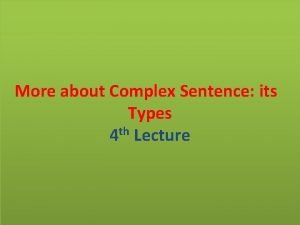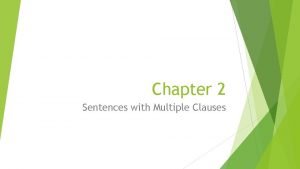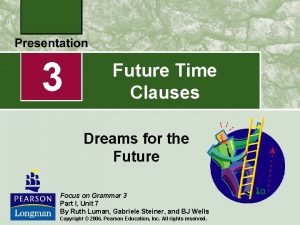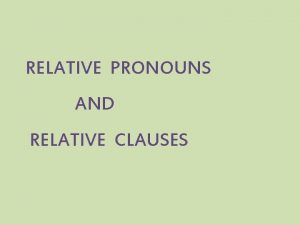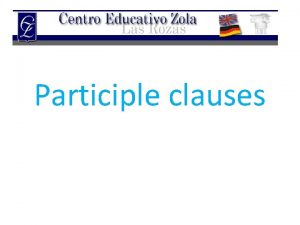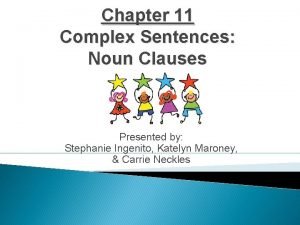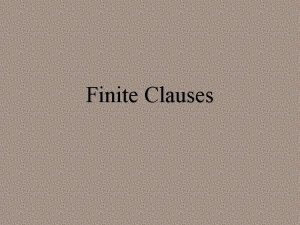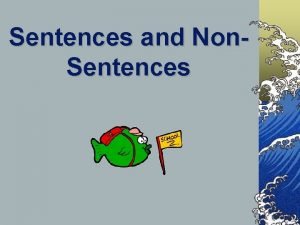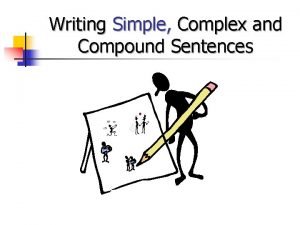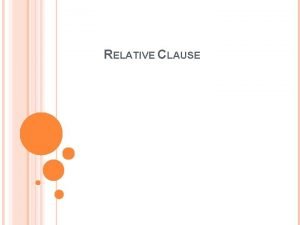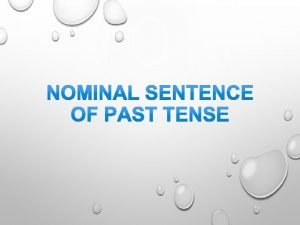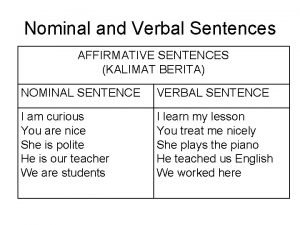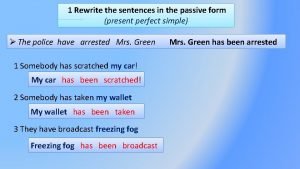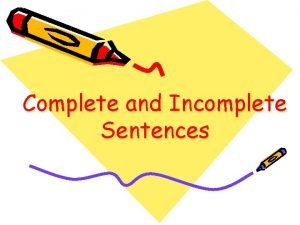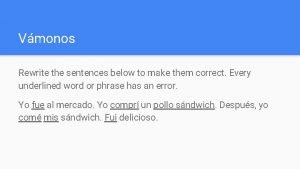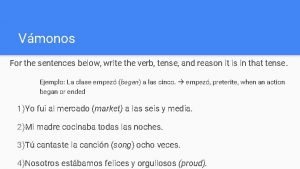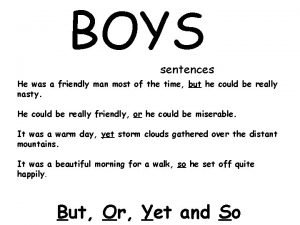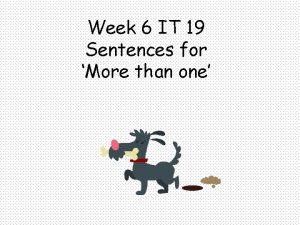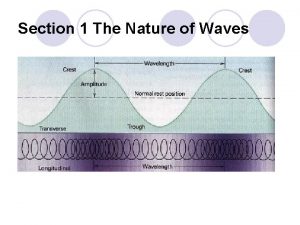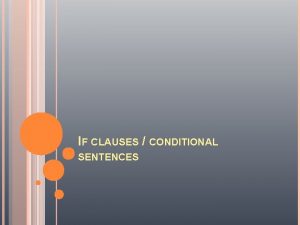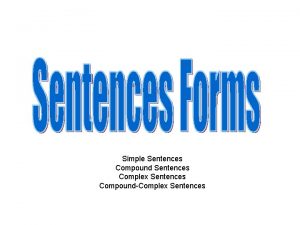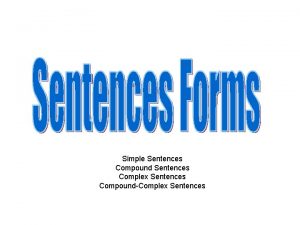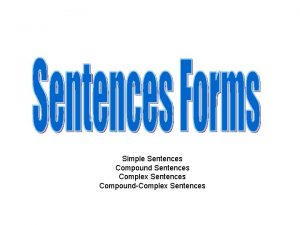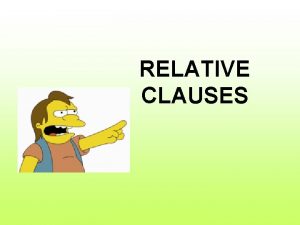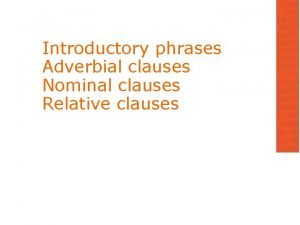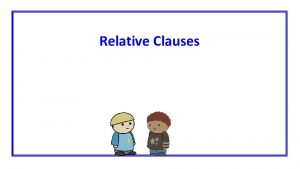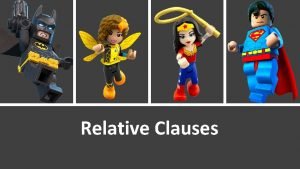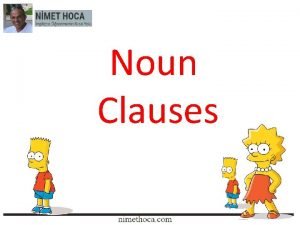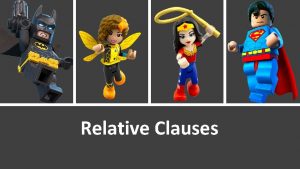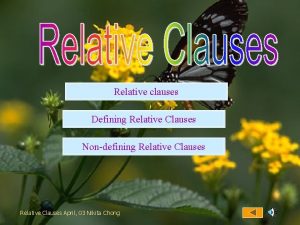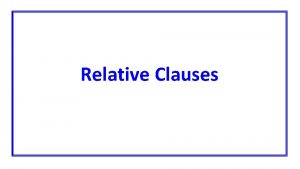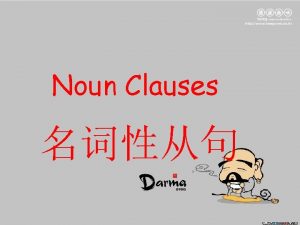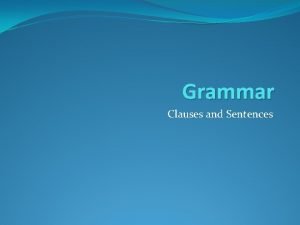More on Form Clauses and Sentences 1412049 More































- Slides: 31

More on Form : Clauses and Sentences 영어영문 1412049 조별이

More on Form : Clauses and Sentences contents Contents • Clauses and Clause Hierarchies • The Rank Scale • Clause Types • More on Tree Diagrams

More on Form : Clauses and Sentences Clauses and Clause Hierarchies (2) Tim thought that Kate believed the story. Sentence Main clause Subordinate clause (4) Tim thought that Kate believed that Greg is a liar. Sentence Main clause 상위절 Subordinate clause 1 상위절 Subordinate clause 2

More on Form : Clauses and Sentences Clauses and Clause Hierarchies finite verb (정형동사), nonfinite verb (비정형동사) finite clauses (정형절) 정형(시제 있는)의 본동사를 가진 절 nonfinite clauses(비정형절) 비정형(시제 없는)의 본동사를 가진 절

More on Form : Clauses and Sentences Clauses and Clause Hierarchies (5) I don’t know if he is happy or sad. is (be 동사의 3인칭 단수 형태) = present form ∴ finite clause

More on Form : Clauses and Sentences Clauses and Clause Hierarchies to-infinitive clause (6) They would hate [Jim to sell his boat]. (Subject O) (7) He likes [to be in Italy in the Spring]. (Subject X) bare infinitive clause (8) She made[Otto polish his shoes. ] (9) A great thing to do is [dance the night away. ] (Subject O) (Subject X)

More on Form : Clauses and Sentences Clauses and Clause Hierarchies -ing participle clause (10) [Billy discussing politics] is rather funny. (Subject O) (11) [Walking with your lover in the rain] is romantic. (Subject X) -ed participle clause (12) [The song finished] he switched off the radio. (Subject O) (13) [Incensed by his comments], he stormed out. (Subject X)

More on Form : Clauses and Sentences Clauses and Clause Hierarchies (14) I don’t know [whether to laugh or cry at his jokes]. (15) I don’t know [whether he would come]. (14)는 nonfinite clause , (15)는 finite clause

More on Form : Clauses and Sentences Clauses and Clause Hierarchies (16) Martin considers [Tim a creep]. (17) Phil deems [Henry foolish]. Small clause (소절) (18) Martin considers [Tim to be a creep]. (19) Phil deems [Henry to be foolish].

More on Form : Clauses and Sentences The Rank Scale (서열척도) “모든 문장은 the word-level, the phrase-level, the clause-level, the sentence-level에서 분석될 수 있다. ”

More on Form : Clauses and Sentences The Rank Scale (20) Tim thought that Kate believed the story. TP VP NP CP N T V C TP NP T N VP V NP Det Tim -ed think that Kate -ed believe the N story

More on Form : Clauses and Sentences The Rank Scale (23) Tim thought that Kate believed that Greg is a liar. TP VP NP CP N T V C NP VP CP T N V C NP VP NP N Tim -ed think that Kate -ed believe that Greg V is Det N a liar

More on Form : Clauses and Sentences Clause Types Cause Types (절 유형) Declarative(서술절) interrogative(의문절) imperative(명령절) exclamative(감탄절)

More on Form : Clauses and Sentences Clause Types Declarative clauses (24) My aunt likes books. (25) You haven’t closed the door. 보통 Statement이지만 발화 맥락에 따라 question이나 directive로 해석될 수 있다.

More on Form : Clauses and Sentences Clause Types Interrogatives clauses (26) Can you see this? (27) Do you agree? Yes/No interrgatives (28) Will you dance with me? (29) What did you eat? (30) Why did you leave? open interrgatives 또는 Wh-interrogatives (31) How did you open the door? (32) Do you want lasagna or spaghetti? (33) Is it red or is it blue? (34) Should I turn left or right? Alternative interrogatives

More on Form : Clauses and Sentences Clause Types Interrogative clauses (35) How many times do I have to tell you not to lick your plate! Rhetorical question (수사학적 질문) (36) Can you be quiet? 통사적으로는 의문절이지만 지시의 의미를 가짐

More on Form : Clauses and Sentences Clause Types Imperative clauses (37) Go home. (38) Mind your own business. (39) Shut up. 보통 directives(지시)로 해석 통사적 특징은 주어가 없고, 동사가 기본형으로 되어있음 (40) Don’t eat that sandwich. (41) Take care of yourself. 명령이 아닌 일종의 바람

More on Form : Clauses and Sentences Clause Types Exclamative clauses (42) What a load of nonsense he talk! (43) How absolutely disgraceful he looks! (29) What did you eat? 감탄절에서는 wh-word가 보통 어떤 구의 수식어 기능을 가지지만 의문절에서는 보통 NP기능을 가짐

More on Form : Clauses and Sentences Clause Types Exclamative clauses (44) What book did you buy? [의문절] (*What a book did you buy? 아님) (45) What a book he bought! [감탄절] (*What book he bought! 아님) (44)에서는 수식요소가 what 한 개, (45)에서는 수식요소가 what과 a 두 개임

More on Form : Clauses and Sentences Clause Types Exclamative clauses (46) A. What an extraordinary lecturer Kate is! B. What an extraordinary lecturer who is? A처럼 감탄절이 진술을 하는 것으로 받아 들여질 수 있으며, B에서처럼 감탄절이 질문도 될 수 있다.

More on Form : Clauses and Sentences Clause Types The pragmatics of the clause types 서술 , 의문, 명령, 감탄 전 형 적 으 로 진술, 질문, 지시, 감탄 syntactic labels (통사론적 용어) pragmatic labels (화용론적 용어)

More on Form : Clauses and Sentences Clause Types The pragmatics of the clause types (47) you haven’t closed the door? (48) My aunt likes WHAT? (49) You want beer or kir? (50) a. I would like some kir. b. Sorry, I didn’t catch that. You want beer or kir? Yes/No question Open question Alternative question

More on Form : Clauses and Sentences More on Tree Diagrams (52) X (52) Y (53) X (mother) Z (sisters) (daughter) Y X Y T Z (daughter) Z U V • X, Y, Z는 nodes(절점) • X는 Y와 Z를 dominate(관할한다) • Y는 Z를 precede(선행한다) W • X는 T, U, V, W도 dominate • 하지만 X와 Y, Z는 immediate dominance (직접관할) 이라고 구분 • T는 U를 immediate precede(직접선 행)하지만 V, W는 precede함

More on Form : Clauses and Sentences More on Tree Diagrams (53) X Y T Z U V W 만약 X가 Y를 dominte(관할)한다면 Y는 X의 constituent(성분)이다. X가 Y를 immediate dominate한다면 Y는 X의 immediate constituent(직접성분)이다.

More on Form : Clauses and Sentences More on Tree Diagrams (54) X Y Z T U V A set of nodes(절점집합) A가 constituent(성분) B를 형성하는 것은 B가 A의 모두를, 그리고 그것들만을 dominate(관할)할 때이다.

More on Form : Clauses and Sentences More on Tree Diagrams 65 p Exercise (53) X Y Y가 U와 T를 dominate함 T sister Z U V W T가 U에 precede함 T와 U는 constituent Y를 형성 (54) X Y Z T U V Z가 W와 V를 dominate함, Z가 W와 V를 immediately Dominate함

More on Form : Clauses and Sentences More on Tree Diagrams 68 p Exercise 1. I suggest that we have some lunch now. True of false? (i) This sentence contains only one clause. F 주절과 that이하의 종속절 가 짐 (ii) This sentence contains two VPs. T suggest 이하와 have 이하, 두 개의 VP (iii) The DO of suggest is an NP. F NP가 아니라 CP임 (iv) The matrix clause is nonfinite. F 현재시제를 쓰므로 finite임

More on Form : Clauses and Sentences More on Tree Diagrams 69 p Exercise 2. Produce labelled bracketings for the trees below. Underline the Heads. S NP VP N V NP [Det S [NP[Det This] [N poison]] [VP [V kills] [NP [N rats]]]] N this poison kills rats

More on Form : Clauses and Sentences More on Tree Diagrams 69 p Exercise 3. Identify the matrix clause and the subordinate clause in the sentences below. Are the subordinate clauses finite or nonfinite? (i) She believes that he is devious. [finite] 주절 종속절 (i) I made her laugh. [nonfinite] 주절 종속절 (ii) Sara concluded that Jamie heard that the story was untrue. [finite] 주절 종속절1 종속절2 (iv) She wanted me to sell my bike. [nonfinite] 주절 종속절

More on Form : Clauses and Sentences More on Tree Diagrams 69 p Exercise 7. Identify the correct tree diagram for the sentence in (i). What’s wrong with the other trees? (b) (i) Doctors cure patients. NP Subject Verb S VP V D. O NP N N Doctors (a) (c) S N V Doctors cure patients S N N patients Doctors VP V N cure patients

Thank You
 Lirik lagu more more more we praise you
Lirik lagu more more more we praise you More more more i want more more more more we praise you
More more more i want more more more more we praise you Adjective from t
Adjective from t Define independent clause
Define independent clause Adverbia clause
Adverbia clause Adverbial phrase examples
Adverbial phrase examples Complex sentence with adjective clause
Complex sentence with adjective clause Multiple clause
Multiple clause Time clauses structure
Time clauses structure Jeopardy relative clauses
Jeopardy relative clauses Participle clause definition
Participle clause definition Complex sentences with noun clauses
Complex sentences with noun clauses Dangling infinitive
Dangling infinitive Relative clauses examples
Relative clauses examples Non sentences
Non sentences Compound sentence examples
Compound sentence examples Present continuous tense interrogative
Present continuous tense interrogative Relative clauses form
Relative clauses form Human history becomes more and more a race
Human history becomes more and more a race Write three positive sentences of nominal sentences
Write three positive sentences of nominal sentences Affirmative sentence example
Affirmative sentence example Rewrite the following sentences in the passive form
Rewrite the following sentences in the passive form Incomplete sentence is called
Incomplete sentence is called Rewrite the wrong sentences
Rewrite the wrong sentences Write the sentences below in the past simple
Write the sentences below in the past simple Our luxury hotel turned out to be a farm building
Our luxury hotel turned out to be a farm building Climbing in a sentence
Climbing in a sentence Ability of two or more waves to combine and form a new wave
Ability of two or more waves to combine and form a new wave The more you take the more you leave behind
The more you take the more you leave behind The more you study the more you learn
The more you study the more you learn Aspire not to have more but to be more
Aspire not to have more but to be more Law of inertia examples
Law of inertia examples



